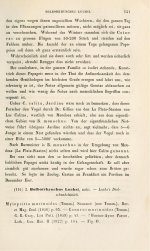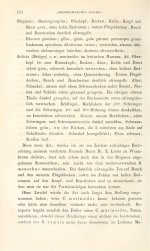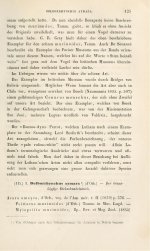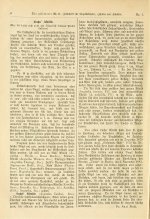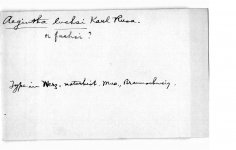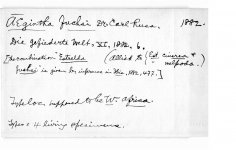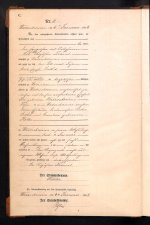Björn Bergenholtz
(former alias "Calalp")

Here´s another almost unknown man commemorated in two Birds … (not considering their respective status, placement or validity)
● the debated Cliff Parakeet; subspecies or species, Myiopsitta (monachus) luchsi FINSCH 1868 a k a (among aviculturist) as "Luchs's -" or "Bolivian Grey-breasted Parakeet".
● … and the invalid "Aegintha luchsi" RUSS 1882 (synonymous to, or hybrid of … ???)
This time we´re dealing with the fairly unknown:
As far as I can find both commemorate the Prussian amateur naturalist and aviculturalist Doctor (physician) Ernst Luchs (1812–1886), whose full name was Karl Johann Nepomuk Ernst Luchs – "Badearts in Warmbrunn" = Spa doctor in Bad Warmbrunn (today's Cieplice Śląskie-Zdrój, in Niederschlesien, Lower Silesia, in South Western Poland) … but even more important, in this context, mentor and friend to Otto Finsch.
This Ernst Luchs, as he was called, was born 1812 in Bad Warmbrunn. After medical studies in Wrocław he returned and worked there his whole life, at the hot baths in the Health resort "Warmbrunn" (the same Bad Warmbrunn). He seem to have left no traces personally in the zoological litterature but he was known in the circle of ornithologists like, for example; Alexander von Homeyer, Alfred Brehm, Karl Russ and the above mentioned Otto Finsch. He apparently had quite a large collection, of both live and stuffed birds, as well as a large ornithological Library. Member in the German Science Academy Leopoldina from 1843 and from 1870 in the German ornithological society Deutsche Ornithologische Gesellschaft (today's Deutsche Ornithologen-Gesellschaft [DO-G]).
When Finsch described the Parakeet (as "Bolborrhynchus Luchsi") in: Finsch, O. 1868. Die Papageien, monographishes bearbeteit … Vol 2: 121-123. (attached) Link to full volume (here) … he did it with the following phrase:
And if anyone of our Polish knowing friend could have a look at this link (here) and explain what it tells us, we might even learn more! Click on the "Show publication content!" to the right!
Cheers!
● the debated Cliff Parakeet; subspecies or species, Myiopsitta (monachus) luchsi FINSCH 1868 a k a (among aviculturist) as "Luchs's -" or "Bolivian Grey-breasted Parakeet".
● … and the invalid "Aegintha luchsi" RUSS 1882 (synonymous to, or hybrid of … ???)
This time we´re dealing with the fairly unknown:
The C. (Carl for Karl) I can understand, but the W. is harder to get … ?Dr C. J. W. E. Luchs (1812-1886) German naturalist, aviculturalist, friend of Finsch (Myiopsitta). [Jobling 2010, and as in his HBW Alive Key 2014]
As far as I can find both commemorate the Prussian amateur naturalist and aviculturalist Doctor (physician) Ernst Luchs (1812–1886), whose full name was Karl Johann Nepomuk Ernst Luchs – "Badearts in Warmbrunn" = Spa doctor in Bad Warmbrunn (today's Cieplice Śląskie-Zdrój, in Niederschlesien, Lower Silesia, in South Western Poland) … but even more important, in this context, mentor and friend to Otto Finsch.
This Ernst Luchs, as he was called, was born 1812 in Bad Warmbrunn. After medical studies in Wrocław he returned and worked there his whole life, at the hot baths in the Health resort "Warmbrunn" (the same Bad Warmbrunn). He seem to have left no traces personally in the zoological litterature but he was known in the circle of ornithologists like, for example; Alexander von Homeyer, Alfred Brehm, Karl Russ and the above mentioned Otto Finsch. He apparently had quite a large collection, of both live and stuffed birds, as well as a large ornithological Library. Member in the German Science Academy Leopoldina from 1843 and from 1870 in the German ornithological society Deutsche Ornithologische Gesellschaft (today's Deutsche Ornithologen-Gesellschaft [DO-G]).
When Finsch described the Parakeet (as "Bolborrhynchus Luchsi") in: Finsch, O. 1868. Die Papageien, monographishes bearbeteit … Vol 2: 121-123. (attached) Link to full volume (here) … he did it with the following phrase:
When Karl Russ described the second "species" under the head-line "Luchs´Astrild" as "Aegintha Luchsi" in: Russ, K. 1882. Luchs´Astrild. Die Gefiederte Welt 11 (1): 6. (attached) Link to full volume (here) … he did it with the following dedication:"Diese neue Art, welche ich als Zeichen aufrichtiger Hochachtung meinem Freunde Herrn Dr. E. Luchs zu Warmbrunn dedicire, lässt schon nach den in der Diagnose angegebenen Kennzeichen, sehr leicht von dem nächstverwandten B. monachus unterscheiden."
Since my knowledge of German is, to say the least meager, I wonder if anyone of our German knowing friends might feel like translating those quotes!? If so, please, as properly as possible, as I would like to translate them myself (to Swedish). And don´t hesitate to remark on any errors I might have done transcribing them!"Ich benannte diesen Astrild zu Ehren eines der tüchtigsten Kenner und liebevollsten Pfleger der Prachtfinken, des Herrn Dr. Luchs in Warmbrunn."
And if anyone of our Polish knowing friend could have a look at this link (here) and explain what it tells us, we might even learn more! Click on the "Show publication content!" to the right!
Cheers!
Attachments
Last edited:




